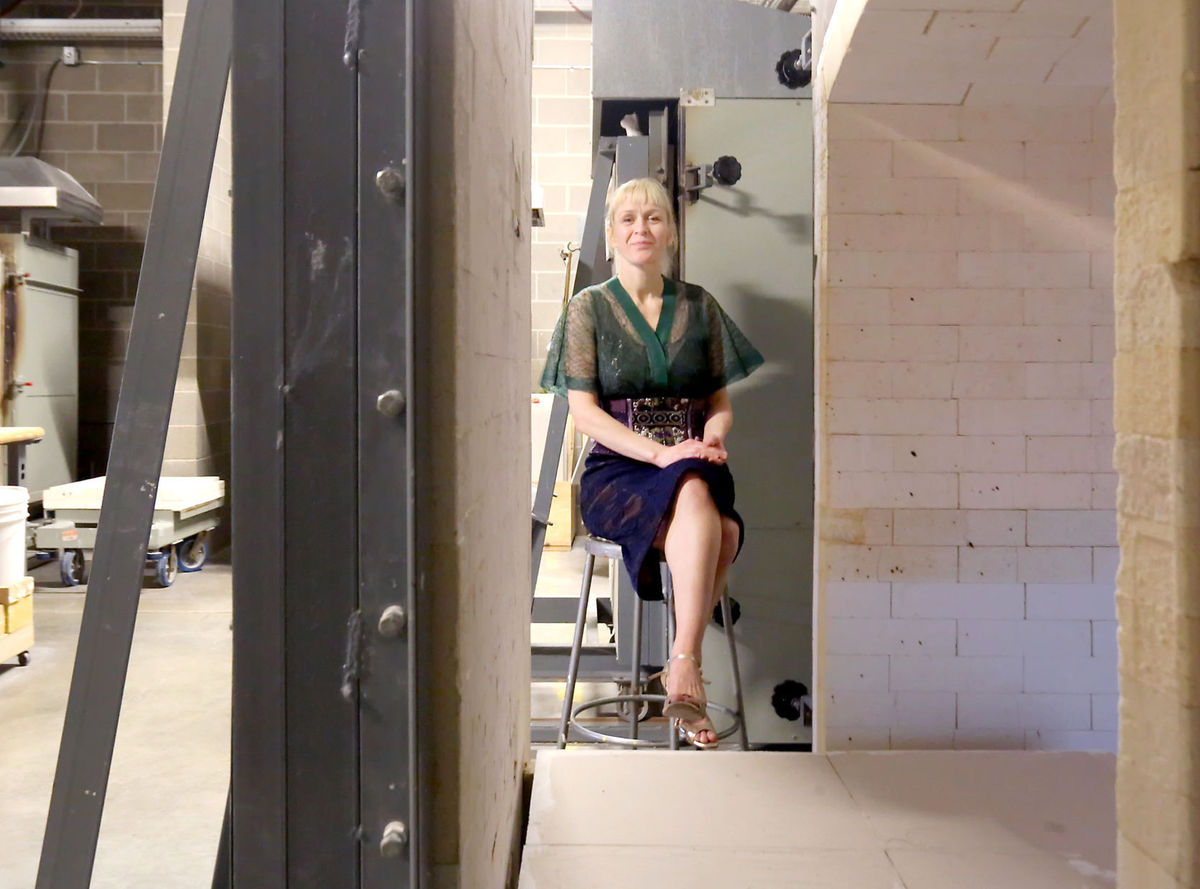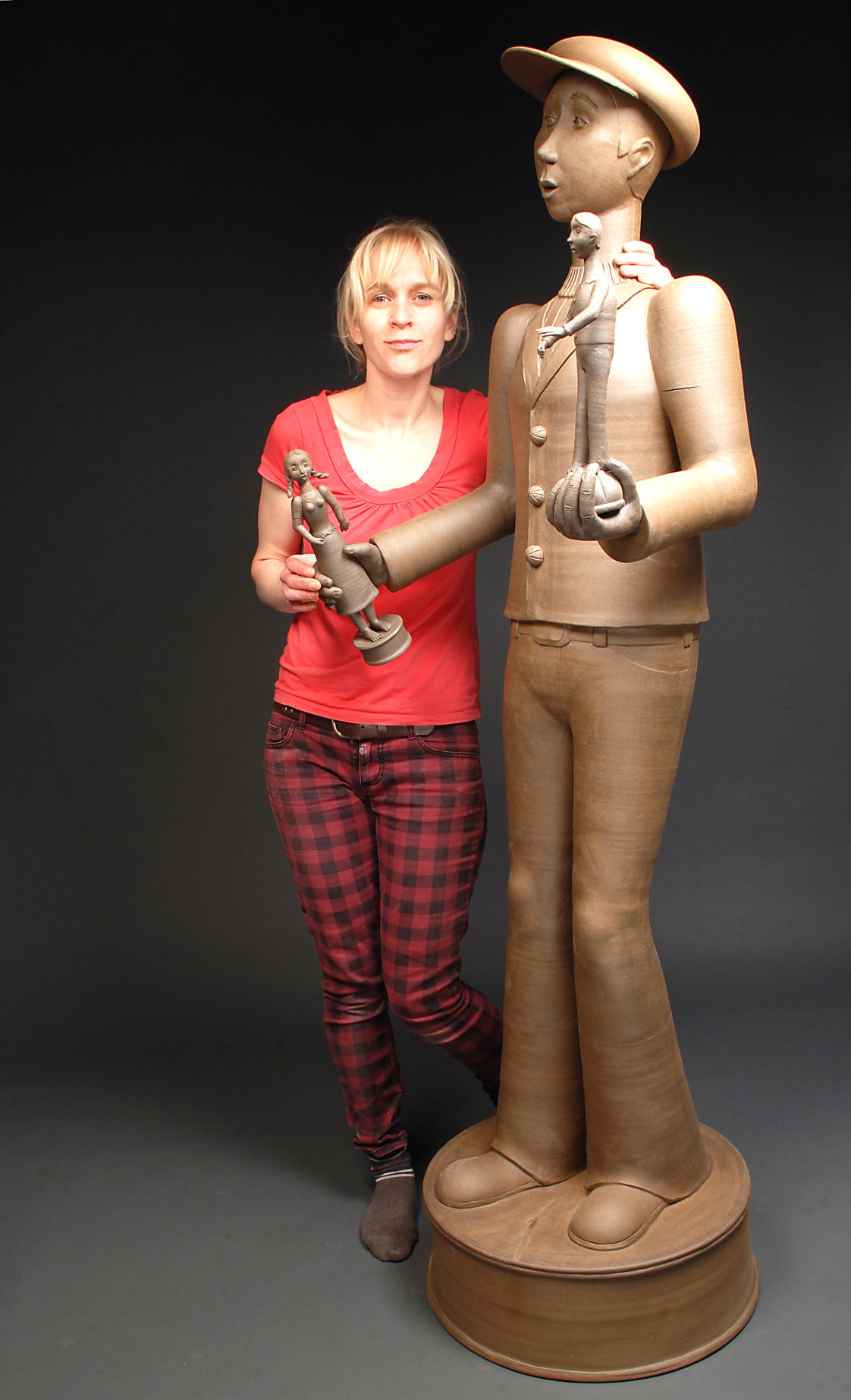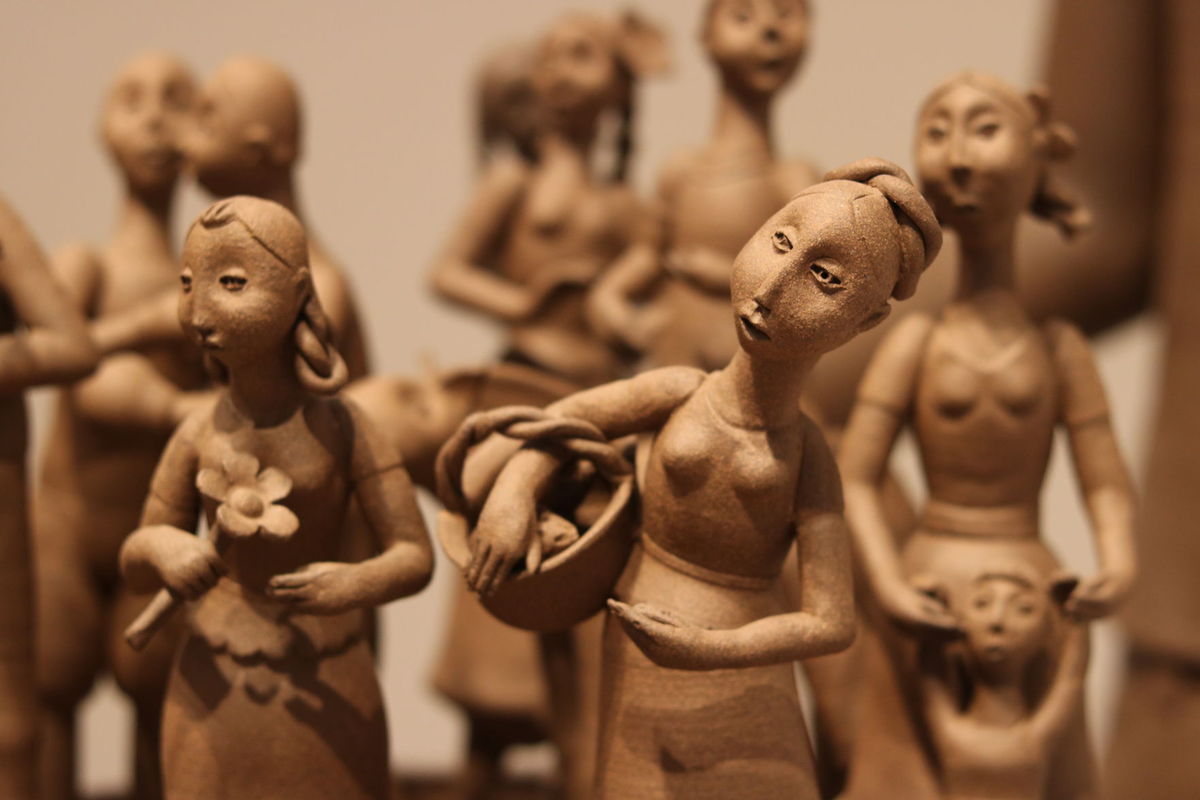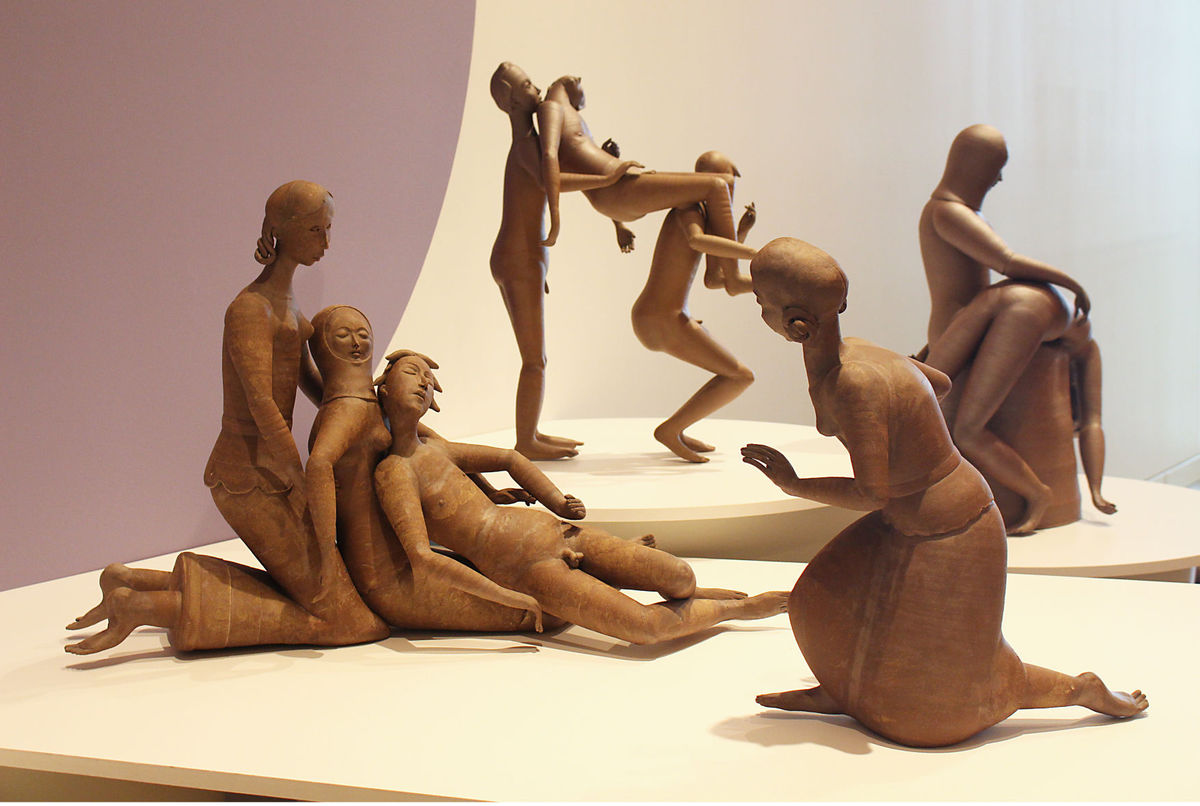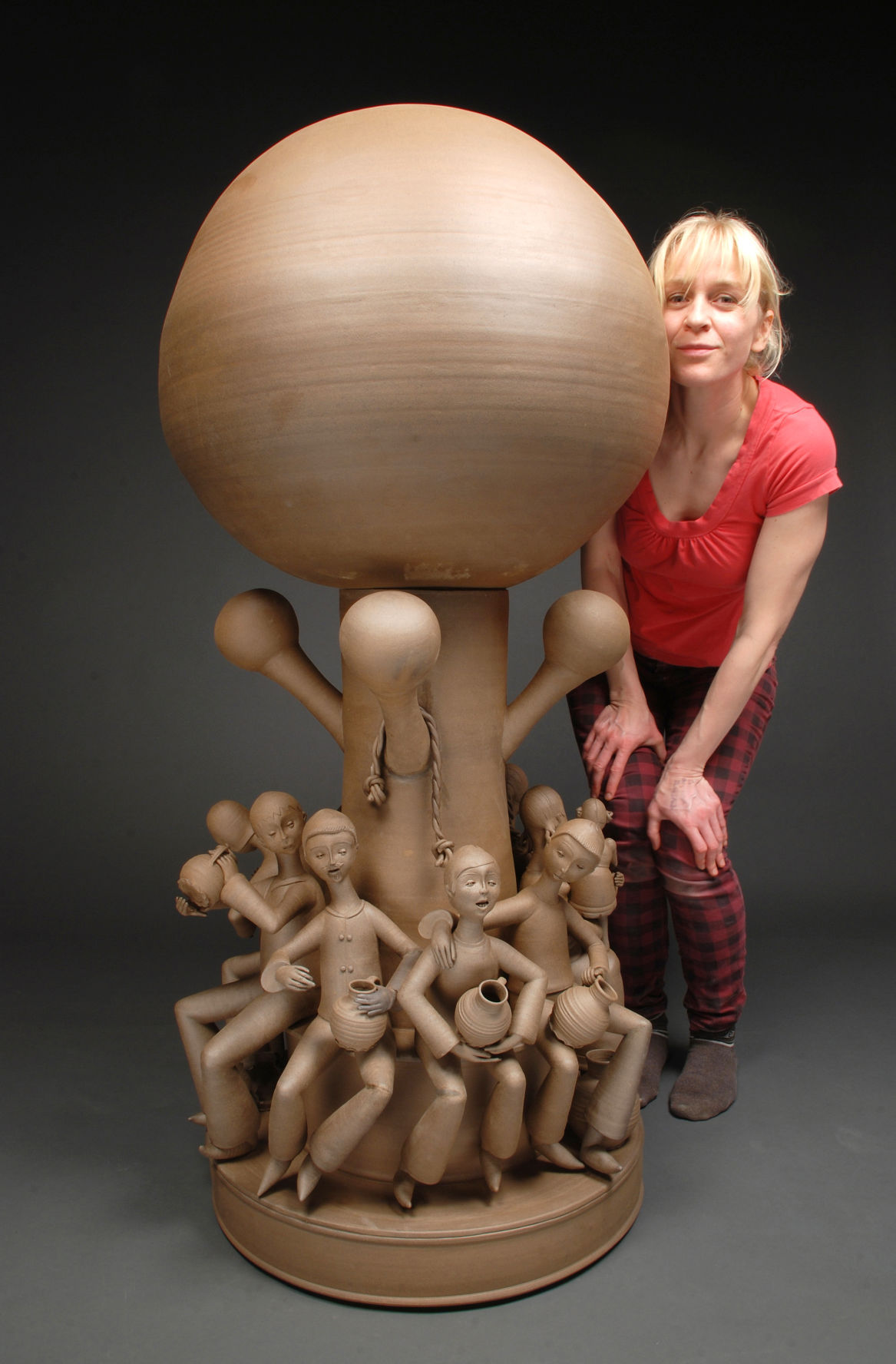UW professor's fairytales in clay are from then and now
GAYLE WORLAND gworland@madison.com | Dec 30, 2017
*to read this article on the Wisconsin State Journal Website please click HERE
The distinctive, compelling work of German-born artist Gerit Grimm, UW-Madison's only ceramics professor, is featured in the show "Gerit Grimm's Fairytales: In A Time Neither Now Nor Then" at the Museum of Wisconsin Art in West Bend through Jan. 14.
JOHN HART, STATE JOURNAL
Many fairy tales begin on an ordinary day. Then, something extraordinary happens.
That’s what occurred in the art studio of ceramicist Gerit Grimm in 2010. Grimm, who had long created ceramics with light colored clay and bedazzling glazes, came across some raw, dark clay that somebody had left behind.
She didn’t like the darkness of the iron-rich clay, so she began to use it up to get rid of it — first by throwing pots on her potter’s wheel and then, by making a little sculpture just for fun.
“I gave the (sculptural) piece to a student to fire, because I didn’t even really care” about it, said the German-born Grimm, who was teaching in California at the time and now heads the ceramics program at UW-Madison.
But the sculpture emerged from the kiln in a way that mesmerized Grimm: cloaked in a deep bronze color with an unglazed sheen.
“It looked like my piece was chiseled into a rock,” she said. “And it had little ripple lines like water lines on top of it, like when a drop falls into the water.
“I felt like the clay started to breathe, and the figure became alive for me,” she said. “I really started preferring that clay. I got rid of all I had in my studio, and just purchased more of that clay, and I went wild.”
Many of the works resulting from that discovery are now on display in “Gerit Grimm’s Fairytales: In A Time Neither Now Nor Then,” at the Museum of Wisconsin Art in West Bend through Jan. 14. The show fills MOWA’s largest gallery and is the biggest exhibition to date of Grimm’s distinctive, often monumental work.
The stoneware sculptures in “In A Time Neither Now Nor Then” are indeed difficult to place in time: They seem at once ancient and contemporary, telling ageless stories. Many were inspired by fairy tales, myths and biblical stories. The death of Grimm’s father last year led to a series of pieces about grief, including Jesus’ lifeless body being carried from the cross.
The show includes 23 groupings of figures — including two dogs, six horses, seven birds and 155 people, often wearing peasant clothing, or wearing nothing at all. Each bears a detailed, uncanny expression.
“There’s quite a lot of ceramics out there that you look at and say, ‘Hmm, I wonder who that’s by?,’” said Graeme Reid, director of collections and exhibitions at MOWA. “You take one look at Gerit’s work and you know it’s her work.”
Colors ranging from ochre to silver emerge from the natural clay in Grimm’s pieces, Reid said. The absence of glaze forces the viewer to concentrate on detail and form.
“The craftsmanship is unbelievable,” he said. “The personality of the work, the creativity that goes into it — to be perfectly honest, we thought if we don’t get her on our schedule for a major show, somebody else in Wisconsin is going to do it.”
Grimm starts many of her works on a potter’s wheel, an unusual approach for a sculptor. She relishes complex pieces that present an engineering challenge — sometimes getting them into the kiln with the use of special braces she designs, as she explained on a video made for a show she did last spring at the Wisconsin Academy’s James Watrous Gallery in Madison.
Grimm, 44, is the sole ceramics professor at UW-Madison, running the program while also teaching and making art. She also travels a great deal, which has had an impact on her style, said Douglas Rosenberg, chair of the university’s art department.
“She’s created a particular course of study for herself that has taken her around the world to study really particular areas of ceramic practice that most people don’t do,” Rosenberg said. “So she’s the repository of a number of very traditional approaches to ceramics that she’s then folded into her own practice — which I think ultimately gives her work the look that it has.”
Historically ‘macho’
Grimm also stands out as one of the few women in her field to head a university ceramics department, Rosenberg noted.
“Ceramics has historically been a very macho, male-dominated space,” he said. “And Gerit’s possibly the only woman in the country, or one of very few, to run a ceramics program.
“Right now I think the (UW-Madison) ceramics program is flourishing in a way that I think it hasn’t in quite some time. I think a lot of it — or all of it — has to do with her,” he said. “She’s put a lot of energy into doing outreach to make herself really visible on campus and around campus.”
Journeyman potter
Grimm grew up in East Germany, where she started in ceramics through a pottery apprenticeship, then worked as a journeyman potter in a pottery factory, creating functional objects like teapots and onion jars. Driven to explore more, she went to art school.
“I grew up in Eastern Europe. We weren’t exposed to pop art and commercial art, like Andy Warhol and those things,” she said. “There weren’t even any colors in our studios. It was all brown in the art school, all Bauhaus tradition: ‘Form follows function.’”
Then, at a ceramics conference in Amsterdam in 2000, Grimm saw the work of American artists for the first time.
“It was this work with bright colors, extremely large, and extremely in-your-face and bold,” she said. “My knees went out. I just felt like butter standing in front of these pieces. It just seemed so freeing to see American ceramicists.”
After the conference, “I pushed my pottery wheel out of my studio and started working” on new projects, she said.
Her professors urged her to explore opportunities in the U.S. and Grimm won a German DAAD government grant — the equivalent of a German Fulbright, she explained — that brought her to the United States.
She moved around the U.S. frequently to study and to teach.
“I just really paid attention to where I could go next — because I really fell in love with America, and I wanted to stay,” she said. In 2012, she came to UW-Madison.
Tango and sailing
Grimm had lived for awhile in Nebraska, then taught in California and at first wasn’t keen on returning to the Midwest. But during her on-campus interview in Madison, she fell in love with the city, she said.
“Once I saw the city and the museums, the Chazen Museum, which is absolutely stunning, and an amazing place of resource, and of course the contemporary art museum on State Street” she was sold, she said.
“The whole city is laid out small, like in a European way. People do sports and are active. They can pursue anything. So this was the top choice for me, to come to the University of Wisconsin-Madison, and to teach ceramics.”
Grimm revived a childhood love of sailing by joining the Mendota Yacht Club, and now skippers a boat every Sunday in the summer on Lake Mendota. She joined the local tango scene, dancing every weekend that she’s not sailing.
Tango is “my winter hobby,” she said. “It’s a nice way to remove yourself from drama or disappointment, or when things don’t work. Because a lot of times, things don’t work.”
“In my studio I’m all by myself, for hours and hours,” she said. “And in sailing and tango, no one talks about everyday life. We talk about sailing, how to make the boat go faster, and in tango, how to improve your skills. You don’t occupy yourself with everyday things. It’s almost like a vacation for the soul.”
As for her latest show, marking 25 years in the ceramics field, “I really like the title ‘In A Time Neither Now Nor Then’ – with a name like Gerit Grimm,” she said.
As far as she knows, her family is not connected with the Brothers Grimm, famous fairy tale authors themselves.
“In Germany there are a lot of people called the name Grimm,” she said. “But apparently in America, there is only one Gerit Grimm.”

